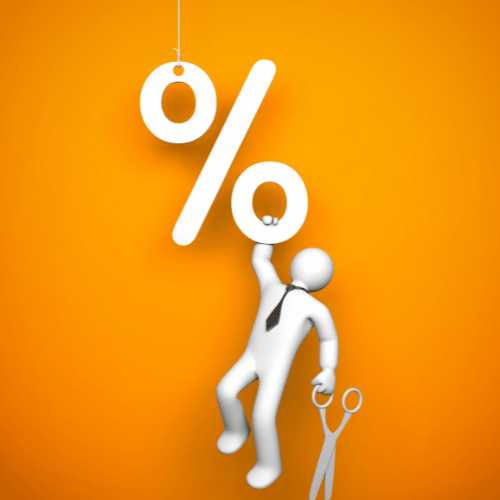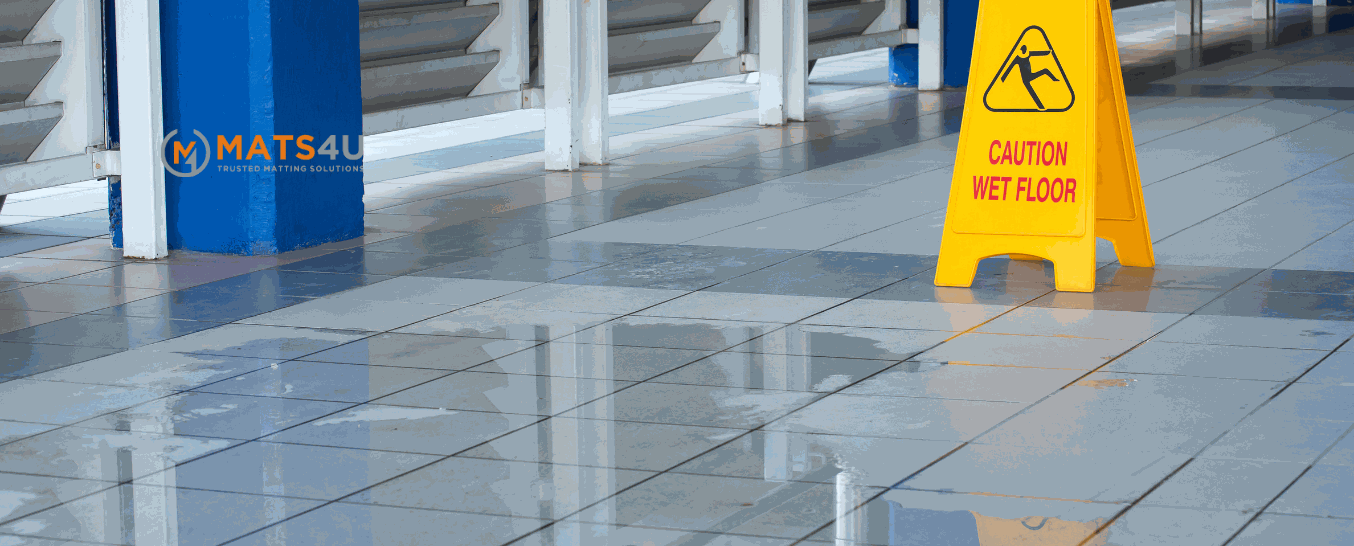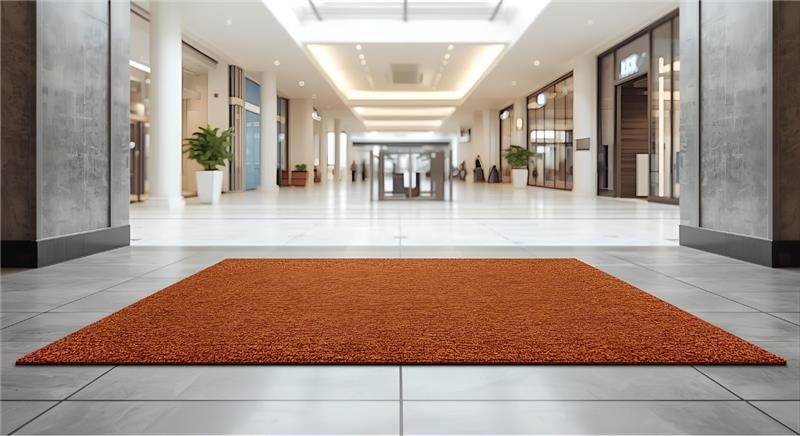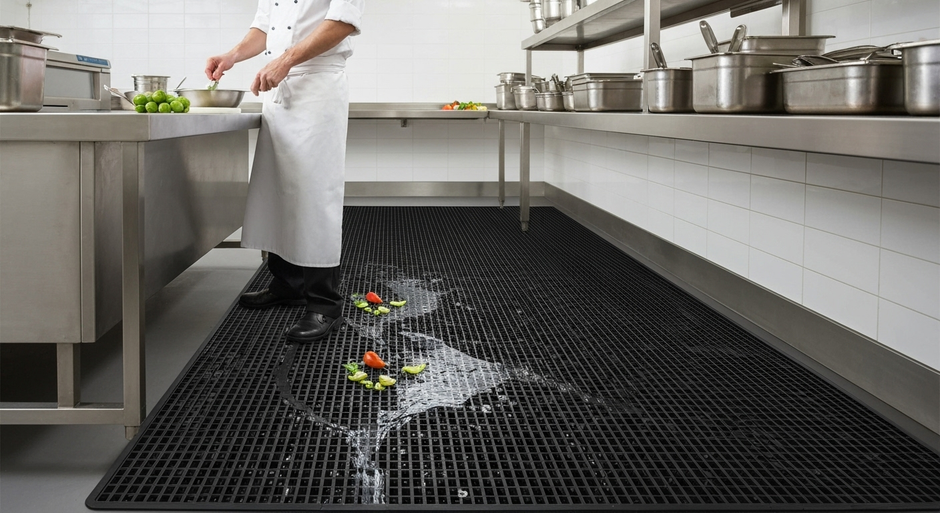Wet Floor Signs and Effective Matting Solutions

Wet floor signs are likely to be out in full force during the winter months, especially on rainy days. Wet floor signs are designed to prevent slip and fall accidents by providing a warning about a wet floor, but do they really? The signs are used so frequently these days (even when the floor isn’t wet) that we have become accustomed to them, and perhaps dont even notice them! It could even be argued that they are obstructive, and a bit of an eye sore!
Did you know that someone can still claim compensation for a slip and fall accident, regardless of whether there was a wet floor sign there? This highlights the importance of not only warning visitors about wet floors, but from preventing the floor from being wet in the first place. Wet floor signs should not be the solution for a) preventing slip and fall accidents and b) preventing compensation claims.
Here is our guide to help you reduce wet floors and wet floor signs in your building:
Identify areas prone to wet floors and spillages
Take a walk around your building and carry out a risk assessment. Are there any areas that could be particularly prone to wet floors? Perhaps near a vending machine or underneath a sink for example?
In these areas, preventative measures need to be put in place, to prevent the floor from getting wet, and in turn preventing slip and fall accidents.
This could include;
- Training the workforce on what they should do if they notice a wet floor
- Using non-slip safety flooring in areas such as kitchens and toilets
- Using non-slip matting in areas prone to drips and spillages
The answer should not be stick a wet floor sign down and walk away!

Regular Cleaning & Maintenance
It is important to have a regular cleaning and maintenance program throughout your premises to ensure that it is clean, safe and tidy at all times, in order to help prevent accidents.
Areas that are more likely to become clean and untidy quickly should be checked more regularly, especially if a wet floor is highly probable.
Areas such as customer and staff toilets should be checked every hour for a possible slip hazard, and rectified immediately.
Effective Entrance Matting
A key factor that can cause wet floors, is water and dirt being brought in on the footwear of customers, visitors and staff from outside when entering your premises.
Without effective entrance matting in place, this water can be tracked further into the building, causing wet floors in areas where sometimes you would least expect them.
If you have entrance matting in place and you are still having to use wet floor signs in your entrances, then you need better entrance mats, as they clearly aren’t doing the job intended!
An effective entrance mat should:
- Stop dirt and water at the door
- Store soil and water for later removal
- Minimise the tracking of soil and water
- Providing a safe surface to walk on
Remove wet floor signs once the floor is dry

A really simple way of reducing the number of wet floor signs in your building, is to remove them once the floor is dry. One of the main reasons we have become so accustomed to wet floor signs, is because sometimes they are still lying around when the floor is dry. The more they are left around when the floor is dry, the less likely people are going to see them as a warning sign.
The Importance of Wet Floor Signs and Effective Matting Solutions
Maintaining a safe environment in both commercial and residential spaces is crucial, especially when it comes to preventing slips and falls. One of the most effective ways to achieve this is by using wet floor signs and the right matting solutions. In this blog, we will explore the importance of wet floor signs and how to mitigate wet floors with the appropriate matting solutions.
The Role of Wet Floor Signs
Wet floor signs are essential tools for alerting people to potential hazards. These signs are typically placed in areas where floors are wet due to spills, cleaning, or inclement weather. The primary purpose of wet floor signs is to prevent accidents by making people aware of slippery surfaces. Here are some key benefits of using wet floor signs:
- Enhanced Safety: Wet floor signs provide a clear visual warning, helping to prevent slips and falls. This is particularly important in high-traffic areas such as entrances, hallways, and restrooms.
- Legal Protection: Using wet floor signs can help protect businesses from liability claims. By clearly marking hazardous areas, businesses demonstrate their commitment to safety and can reduce the risk of legal issues arising from accidents.
- Customer Confidence: When customers see that a business is taking steps to ensure their safety, it can enhance their confidence and trust in the establishment.
Effective Placement of Wet Floor Signs
To maximize the effectiveness of wet floor signs, it is important to place them strategically. Here are some tips for proper placement:
- High-Traffic Areas: Place signs in areas where people are most likely to encounter wet floors, such as entrances, exits, and hallways.
- Near Spills and Leaks: Immediately place signs around spills or leaks to alert people to the hazard.
- During Cleaning: Use wet floor signs during and after cleaning to warn people of wet surfaces.
- Visibility: Ensure that signs are highly visible and placed at eye level to catch people’s attention.
Mitigating Wet Floors with the Right Matting Solutions
While wet floor signs are crucial for safety, combining them with the right matting solutions can further reduce the risk of slips and falls. Here are some effective matting solutions to consider:
- Entrance Mats: Placing high-quality entrance mats at all entry points can significantly reduce the amount of moisture and dirt tracked indoors. These mats should be durable, absorbent, and have a non-slip backing to stay in place.
- Absorbent Mats: In areas prone to spills, such as kitchens and restrooms, absorbent mats can help soak up liquids and prevent them from spreading. These mats are designed to quickly absorb moisture, keeping the floor dry and safe.
- Anti-Slip Mats: For areas where wet floors are common, such as near sinks and water fountains, anti-slip mats provide additional traction to prevent slips. These mats are made from materials that offer excellent grip, even when wet.
- Drainage Mats: In environments where water is frequently present, such as commercial kitchens and industrial settings, drainage mats allow liquids to flow through, keeping the surface dry and reducing the risk of slips.
Choosing the Right Matting Solution
Selecting the right matting solution involves considering the specific needs of your space. Here are some factors to keep in mind:
- Material: Choose mats made from durable materials that can withstand heavy foot traffic and frequent cleaning. Common materials include rubber, vinyl, and polypropylene.
- Size and Placement: Ensure that mats are large enough to cover the area effectively and are placed in strategic locations to maximize their effectiveness.
- Maintenance: Regularly clean and maintain mats to ensure they remain effective. This includes vacuuming, washing, and replacing mats as needed.
Conclusion
In conclusion, using wet floor signs in combination with the right matting solutions is essential for maintaining a safe environment. Wet floor signs provide immediate visual warnings of potential hazards, while effective matting solutions help to mitigate the risk of wet floors. By strategically placing wet floor signs and choosing the appropriate mats, you can significantly reduce the risk of slips and falls, protect your flooring, and enhance the overall safety and appearance of your space. Invest in high-quality wet floor signs and matting solutions today to ensure a safer environment for everyone.
How can we help you?
Here as Mats4U we have a range of matting that can help to stop water and dirt, which can in turn reduce the number of wet floor signs in your building. Take a look at the best entrance mats in the industry, as well as non-slip safety mats on our website.
If you are unsure which mats you need, or have a particular problem area that you would like to discuss, please do not hesitate to contact us. We are available Monday – Friday, 9am – 5pm on 0121 313 6748, or you can email us at sales@mats4u.co.uk. We are more than happy to give you any help and advice that you need.
To stay up to date with new products and information please follow us on Linkedin









